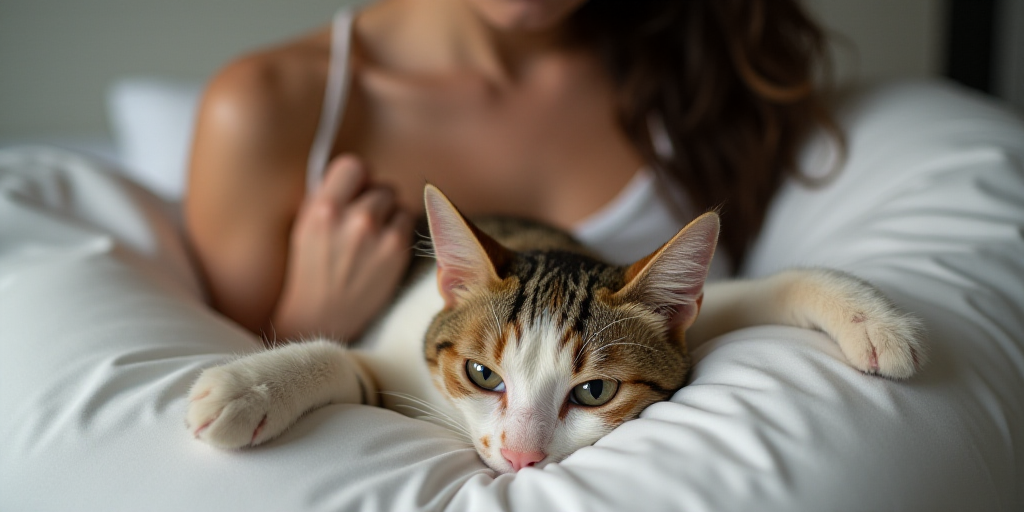The Role of Oxytocin in Strengthening the Bond
Despite their reputation for independence, recent research suggests a unique connection between humans and cats, driven by brain chemistry. The key player here is oxytocin, often referred to as the “love hormone.” This neurotransmitter fosters trust and affection, similar to the release when a mother cradles her baby or friends embrace each other.
Oxytocin plays a crucial role in social bonds, trust, and stress regulation across various species, including humans. A 2005 study showed that it made participants more willing to trust others during financial games. Moreover, oxytocin has calming effects on both humans and animals by suppressing the stress hormone cortisol and activating the parasympathetic nervous system, aiding the body in relaxation.
The Effects of Petting a Purring Cat
While cats may be more subtle in expressing affection, their owners often report similar feelings of companionship and stress relief as dog owners. Research increasingly supports these anecdotal accounts.
Scientists have long known that friendly interactions trigger oxytocin release in both dogs and their owners, creating a cycle of bonding. However, until recently, little was known about its effect on cats.
A 2021 Japanese study reported that brief sessions of petting their cats increased oxytocin levels in many owners. Women interacted with their pets for a few minutes while scientists measured the owners’ hormonal levels. The results suggested that friendly contact (petting the cat, speaking in a soft tone) was linked to increased oxytocin in human saliva compared to a quiet rest period without their cat.
Many people find petting a purring cat relaxing, and research indicates it’s not just due to their soft fur. The act of petting and even the sound of purring can trigger oxytocin release in our brains. A 2002 study discovered that this response, provoked by gentle contact with a cat, helps reduce cortisol (our stress hormone), which can lower blood pressure and even alleviate pain.
When is Oxytocin Released Between Cats and Humans?
Research is identifying specific moments that trigger oxytocin release in our interspecies friendship. Soft physical contact seems to be the primary catalyst for cats.
A February 2025 study found that when owners gently caressed, hugged, or rocked their cats without forcing interaction, both the owners’ and cats’ oxytocin levels tended to rise. The researchers monitored the hormone in cats during 15 minutes of play and cuddling at home with their owner.
Cats who initiated contact, such as sitting on their owner’s lap or nudging with their nose, showed increased oxytocin. The more time they spent near their humans, the greater the increase.
What about less affectionate cats? The same study observed different patterns in cats with more anxious or distant attachment styles. Evasive cats (those maintaining distance) showed no significant changes in oxytocin, while anxious cats (constantly seeking their owner but easily overwhelmed by manipulation) had high oxytocin levels from the start.
The study found that evasive and anxious cats’ oxytocin dropped after a forced hug. When interactions respect the animal’s comfort, the bonding hormone flows; however, when a cat feels cornered, it retreats.
Humans might learn from their feline friends about managing attachment styles. The key to bonding with a cat is understanding how they communicate. Unlike dogs, cats don’t rely on prolonged eye contact to form bonds; instead, they use subtle signals. The most recognized is the slow blink, a feline smile conveying security and confidence.
Purring also plays a significant role in connecting with people. Deep purring has been linked not only to self-healing in cats but also to calming effects on humans. Hearing this distinctive sound can lower heart rate and blood pressure, with oxytocin mediating these benefits.
The daily company of a cat, reinforced by these small oxytocin boosts from interactions, can act as a buffer against anxiety and depression, sometimes providing comfort equivalent to human social support.
Are Cats Less Affectionate Than Dogs?
Studies often find stronger oxytocin responses in human-dog interactions. In a notable 2016 experiment, scientists measured oxytocin in pets and owners before and after ten minutes of play. Dogs showed an average 57% increase in oxytocin post-play, while cats showed around a 12% rise.
In humans, oxytocin levels rise during significant social interactions. Studies show that contact with a loved one produces stronger oxytocin responses than contact with strangers. Thus, a dog’s enthusiastic greeting mirrors the emotion felt upon seeing a child or partner.
Dogs, being domesticated pack animals bred for constant human companionship, are almost programmed to seek out human contact, gestures, and approval, stimulating oxytocin release in both parties. Cats, evolving from solitary hunters who didn’t need overt social cues to survive, may not display oxitocin-driven behavior as readily or consistently. Instead, they might reserve the release of this hormone for when they feel truly secure.
A cat’s trust isn’t automatic; it must be earned. But once granted, it’s reinforced by the same chemical that unites parents, partners, and human friends.
So, the next time your cat slowly stares at you from across the couch or curls up and purrs in your lap, remember that something invisible is also happening: oxytocin levels are rising in both brains, deepening trust and easing the daily stresses of life. Cats, in their way, have harnessed the ancient biology of love.






